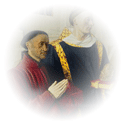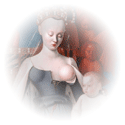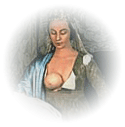 During the fifteenth century, France was divided into feudal holdings that in
theory were under one royal rule. Many of them, however, were richer and more powerful
than the king himself and respect the English supremacy.
Being on exile in 1422, Charles VII succeeded his father Charles VI and
return to France.
Partly with the aid of Joan of Arc the revitalized King´s forces captured Paris in 1436.
Slowly Charles VII began firmly establish the power and wealth of the monarchy.
Under his rule
the French royal court again became a major source of patronage for the arts.
During the fifteenth century, France was divided into feudal holdings that in
theory were under one royal rule. Many of them, however, were richer and more powerful
than the king himself and respect the English supremacy.
Being on exile in 1422, Charles VII succeeded his father Charles VI and
return to France.
Partly with the aid of Joan of Arc the revitalized King´s forces captured Paris in 1436.
Slowly Charles VII began firmly establish the power and wealth of the monarchy.
Under his rule
the French royal court again became a major source of patronage for the arts.
By about 1445, an outstanding, young court artist of the period Jean Fouquet (1420-1481) was appointed as a court painter, portraitist, illuminator and designer to paint portraits of Charles VII, his family and his courtiers, as well as make illustrations for his manuscripts. Among the court officials painted by Fouquet is Étienne Chevalier, French Ambassador to England and from 1450 Treasurer to Charles VII of France.
 Following a vow he made on Anges Sorel death in 1450, Étienne Chevalier, the great patron of the painter, commissioned a
diptych to present it to the Notre-Dame Church in Melun.
Following a vow he made on Anges Sorel death in 1450, Étienne Chevalier, the great patron of the painter, commissioned a
diptych to present it to the Notre-Dame Church in Melun.
The composition of the diptych is very simple but charming. It portrays Madonna and Child
in the central wing
and Étienne Chevalier with his saint patron St. Stephen (Étienne is French for Stephen) in the site wing.Straight depicted figures of Étienne and his patron (Fouquet self-portrait)
recalls Giorgione by its vigor and delicacy from one site, and Flemish realism in depicting details as carefully as the
reflection in a mirror from the other. Kneeling in prayer with clasped hands Chevalier and his standing patron are
dressed in the cloths that has been in fashion at the time of painting. Étienne is wearing red, short robe
and his saint is wearing a usual dark blue, long deacon´s robe with golden strips.
In his hand the saint is holding a closed Gospel book with jagged stone on it - a symbol of his martyrdom.
According to the legend he was stoned to death for preaching Christianity. A trickle of blood can also be seen on
his tonsure. On the wall of the church built in early
Italian Renaissance style behind Étienne´s head the name Étienne
Chevalier is inscribed several times.
 In their intimacy the donor and the saint are looking towards nursing the Infant Jesus Madonna surrounded by angel,
who occupied the central wing of the diptych. Invisible, mystic power draws donor´s and saint´s,
as well as accidental guest´s eyes
to Madonna´s perfectly round bare breast at the center of the painting. The same power
draws their eyes to admire the rest of her great beauty: her
higher forehead so fashionable at the period, her slim waist, her crown sumptuously adorned
with stones and pearls, and luxurious throne on which she is sitting with distinction of a queen.
Infant Jesus (could be any
child) seems to be added to the scene to render the scene sacred resemblance.
The exposure of her perfect round, firm breast presents an erotic value on its own.
The unreal contrast of red (Seraphim) and blue (Cherubim) angels, so admired by Ghirlandaio (1449-14949),
and Madonna´s mysterious countenance add to the painting unreal, surrealistic character.
It is a remarkable, controversial work of its time, almost bordering on the profane.
In their intimacy the donor and the saint are looking towards nursing the Infant Jesus Madonna surrounded by angel,
who occupied the central wing of the diptych. Invisible, mystic power draws donor´s and saint´s,
as well as accidental guest´s eyes
to Madonna´s perfectly round bare breast at the center of the painting. The same power
draws their eyes to admire the rest of her great beauty: her
higher forehead so fashionable at the period, her slim waist, her crown sumptuously adorned
with stones and pearls, and luxurious throne on which she is sitting with distinction of a queen.
Infant Jesus (could be any
child) seems to be added to the scene to render the scene sacred resemblance.
The exposure of her perfect round, firm breast presents an erotic value on its own.
The unreal contrast of red (Seraphim) and blue (Cherubim) angels, so admired by Ghirlandaio (1449-14949),
and Madonna´s mysterious countenance add to the painting unreal, surrealistic character.
It is a remarkable, controversial work of its time, almost bordering on the profane.
The model for Madonna is traditionally said to be Agnes Sorel, the Charles VII´s mistress, the firstwoman in France to hold that semiofficial position. Her great beauty captivated the King, whose love for her remained constant until her death. Her charm, loveliness and intelligence made her to be a queen admired not only by King of France but also by his officials. Her relationship with Étienne Chevalier was not entirely political. It was not a secret that Chevalier burned to her with tender affection. An eighteenth-century inscription on the back of the panel tells us that the diptych of Melun was commissioned by Étienne following a vow he made on her death in 1450.
According to a description of the diptych left us by Denis Godefroy, who had seen it in 1661, the original frames were covered in blue velvet with the donor´s initials woven in pearls and gold, and silver threads, linked together in the shape of eights "lacs d´amour" (lake of love) as a symbol of deep affection. There were also gilded medallions on which stories of the saints were represented.
This first public recognition of his mistress by a king of France scandalized people and awakened jealousy and intrigue, which brought her death by poison in the age of 28. Johan Huizinga in his "The Waning of the Middle Ages" (polish translation "Jesien Sredinowiecza") described this painting as a most appalling example of a dangerous blend of amorous and religious feelings. "There is a flavor of blasphemous boldness about the whole," he wrote. John Halle in "The civilization of Europe in the Renaissance" quotes: "Artists used the features of people known to them and to their audience as attendants in religious narrative, even as Filippo Lippi did in Italy and Jean Fouquet in France, nonchalantly using the mistress they possessed or pained after as models for Mary.".
From 1461 until about 1775 the diptych was in the chancel of the Church
of Notre-Dame at Melun. About 1776, against donor´s will, the two parts of diptych
were separated forever and never reunited except for a short time at Paris during the Exposition of the French "Primitives" in 1904.
"Madonna with Child" is property of Koninklijk Museum voor Schone Kunsten and can be seen in Anvers,
Belgian,
In 1896 "Étienne with a Saint" found its way to the Berlin Museum. Now it can be seen in
Staatliche Museum, Berlin, Germany
 Fouquet´s influence on posterity has been considerable.
His style has at least two striking characteristics. In depicting the human countenance, he possessed a rare gift
of taking life,
as it was, and nobody before him could tell and depict a story as he could.
Many of the painters remain under the influence of his Madonna´s perfectly round bare breast indisputable charm. The reminiscence
of it can be found in the works of great French historical painters, Poussin and
Delacroix, impressionists, Gugain, as well as in 20th century modern art, Cindy Sherman.
Fouquet´s influence on posterity has been considerable.
His style has at least two striking characteristics. In depicting the human countenance, he possessed a rare gift
of taking life,
as it was, and nobody before him could tell and depict a story as he could.
Many of the painters remain under the influence of his Madonna´s perfectly round bare breast indisputable charm. The reminiscence
of it can be found in the works of great French historical painters, Poussin and
Delacroix, impressionists, Gugain, as well as in 20th century modern art, Cindy Sherman.